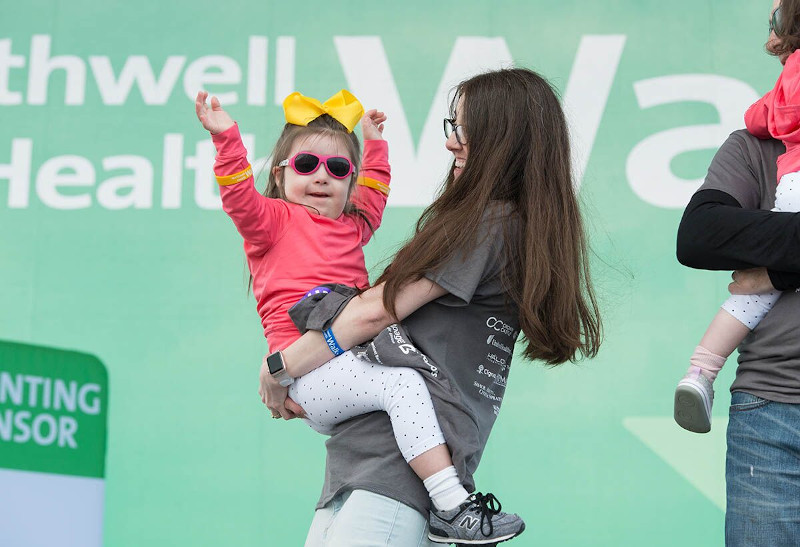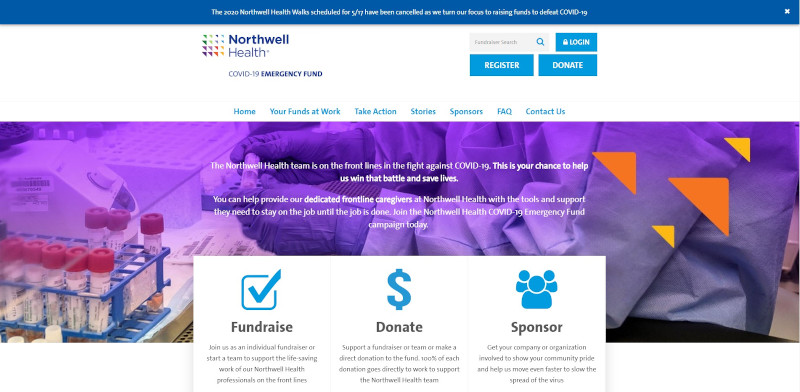How One NYC Foundation Took Their Signature Event Virtual
Jenny Love
Published: 05/12/2020

Because of her New York City location, Lori Peterson found herself at the epicenter of the Covid-19 response in the United States. Lori coordinates community fundraising efforts for the 23 hospitals, 750 community care locations, and 72,000 employees that make up Northwell Health in New York City, Long Island, and Westchester County, NY.
In March, Lori and her team were in the midst of planning their annual fundraising walk, scheduled for May. Eight hundred people had already registered, sponsors were secured, and they were on pace to raise over $1 million. Then the pandemic hit.
Making the Pivot to a Virtual Event
“As things started to change day by day, as the virus was becoming bigger and bigger, we had to think very quickly, not only about community fundraising, but fundraising as a whole,” Lori said.
Not willing to give up on one of their biggest events, Lori and her team gathered with Olive Isaacs, director at Eventage, the event strategy and production firm they had partnered with for the past eight years, to brainstorm options. Knowing that an in-person event would be out of the question, the group faced three options: postpone, cancel, or change the event to a virtual format. They quickly concluded that going virtual would be the best way to preserve both participant and sponsor revenue.
Virtual Event vs. Virtual Campaign
There were two options for moving the walk online: a virtual event or a virtual campaign.
“We wanted an event, something that really would take the place of the walk, and that people could still rally around and feel that sense of community that they did on an actual live walk day,” Olive said. “But [a virtual event] didn't give us an opportunity to reach out to an audience much larger than those had been that had been connected to us through our walk program before.”
An online campaign, by contrast, could facilitate donations from a larger audience. But a campaign wouldn’t require anyone to sign up as a participant or do peer-to-peer work, and Northwell didn’t want to lose the large network of people who had already signed up to do just that.
In the end, the team used the DonorDrive virtual events platform to blend aspects of both.
“We set it up so that it could operate as a peer-to-peer event where people could register as fundraisers, invite others to join them, ask for donations, and start teams,” Olive said. “But we also retained the elements of the campaign, where people could simply make a straight donation.”
Same Campaign Platform, New Messaging
Once they decided how to move forward with the campaign, it was time to rethink and develop the new brand. The new campaign needed to fit within the Northwell Health brand’s look, feel and tone and to match the urgency and seriousness of the campaign's purpose.

“Within 72 hours, our team put together a new site, a new home page, navigation menu items and content pages,” said Ally Brooks, a senior manager at Eventage.
Working with their existing DonorDrive template, the Northwell team focused on two main calls to action: register and donate. They updated messaging for personal pages and created resources for outgoing communications with news about the walk cancellation and the addition of the Covid emergency fund.
Because Northwell Health is made up of many hospitals and community care locations, both donors and fundraisers were given the option to choose which hospital or program they wanted to fund, and whether they wanted to designate their funds or donate to general Covid relief.
A New Approach to Advertising
Getting the word out about the revised event presented a unique challenge, because the hybrid event-campaign model meant that the Northwell team had to appeal to two distinct audiences: peer-to-peer supporters and donors.
“Peer-to-peer folks are typically women aged 30 to 55, parents, doers,” said Amin Tehrani, managing director at Revunami, a digital strategy firm. “These are the folks who put signs in their yards or dump a bucket of ice on their heads. Direct-response donors are typically older. They write you a check.”
On the plus side, quarantine had caused a spike in social media, and peer-to-peer programs and social networks have a lot of overlap. Because travel and entertainment companies, and even universities had pulled much of their advertising, the cost for putting ads out there had dropped tremendously. People were bored and looking for a way to feel useful and connected. And health care workers and health systems were in a new position to be lauded as heroes.
“We looked at this and saw maybe we can turn all those folks who are putting signs in their yards, cheering, or sending thank-you cards into actual supporters of the organization,” Amin said. “We had the opportunity to broaden the reach of Northwell fundraising to these people’s social networks, regardless of their geography, rather than having it be focused on fundraising from the New York area.”
Because of the need to change course quickly, Amin initially placed ads using Northwell stock photos and a message about staying home. But as time has gone on, the team has evolved messaging to be more authentic and make people feel connected in the fight against Covid-19, for example by featuring fundraising pages created by patients and their families grateful for the care they had received at Northwell when hospitalized for the virus.
Success in a New Format
The results speak for themselves. So far, digital advertising has yielded a 6:1 return on investment, and community fundraisers have raised almost $900,000 in the fight against Covid-19.
“We had the opportunity to bring our cause to a new audience and acquire new donors nationwide," Ally said.
Want to learn more? Hear the full story of Northwell's pivot.